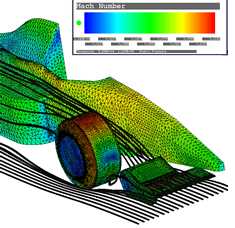
|
|
||||||||

Super Models
The development of computational fluid dynamics (CFD) as a design and trouble-shooting analysis tool is one of the engineering achievements emanating from the Department of Engineering during the last twenty-five years. It began in the area of turbomachinery and aeronautics. Prof John Denton, working at the Whittle Lab in the 1980s, made important developments to the technique with application to turbomachinery blading. His methods were further developed by Professor Bill Dawes and then by Bill and Dr Stewart Cant and Dr Mark Savill to work on the design of the external structure of an aircraft as well as all aspects of turbomachinery, affecting performance, life, cost, noise and emissions. This team, working closely together, developed very powerful and necessarily accurate tools for analysing complex flows.
|
|
This simulation investigates the inter-component effects of changes in front wing and endplate geometry on the aerodynamic performance of an F1 car as a whole. The geometry modelled is a generic design developed in-house which conforms to present regulations, and complements a series of experimental tests. The mesh shown here has around 750,000 cells. Image generated by Will Kellar. |
